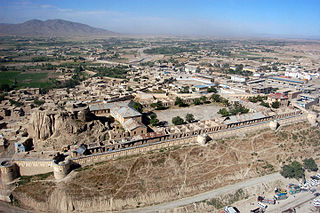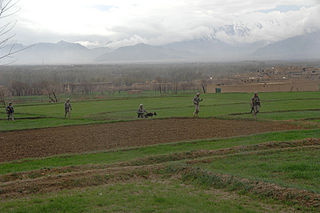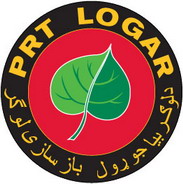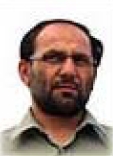
Baghlan is one of the thirty-four provinces of Afghanistan. It is in the north of the country. As of 2020, the province has a population of about 1,014,634.

Ghazni is one of the 34 provinces of Afghanistan, located in southeastern Afghanistan. The province contains 19 districts, encompassing over a thousand villages and roughly 1.3 million people, making it the 5th most populous province. The city of Ghazni serves as the capital. It lies on the important Kabul–Kandahar Highway, and has historically functioned as an important trade center. The Ghazni Airport is located next to the city of Ghazni and provides limited domestic flights to Afghanistan's capital, Kabul.

Logar (Farsi: لوگر; meaning Greater Mountain is one of the 34 provinces of Afghanistan located in the eastern section of the country. It is divided into 7 districts and contains hundreds of villages. Ahmadzai Pashtuns are influential in this region. Puli Alam is the capital of the province. As of 2021, Logar has a population of approximately 442,037. It is a multi-ethnic tribal society, with a 55% Tajik and 32% Pashtun majority.

Paktia is one of the 34 provinces of Afghanistan, located in the east of the country. Forming part of the larger Loya Paktia region, Paktia Province is divided into 15 districts and has a population of roughly 623,000, which is mostly a tribal society living in rural areas. Pashtuns make up the majority of the population and a small percentage include Tajiks Gardez is the provincial capital. The traditional food in Paktia is known as (dandakai) which is made from rice and mung bean or green gram.

Sar-e Pol, also spelled Sari Pul, is one of the thirty-four provinces of Afghanistan, located in the north of the country. It borders Ghor and Bamyan to the south, Samangan to the east, Balkh and Jowzjan to the north, and Faryab to the west. The province is divided into 7 districts and contains 896 villages. It has a population of about 632,000, which is multi-ethnic and mostly a tribal society. The province was created in 1988, with the support of northern Afghan politician Sayed Nasim Mihanparast. The city of Sar-e Pol serves as the provincial capital.

Paktika is one of the 34 provinces of Afghanistan, located in the eastern part of the country. Forming part of the larger Loya Paktia region, Paktika has a population of about 789,000, mostly ethnic Pashtuns. The town of Sharana serves as the provincial capital, while the most populous city is Urgun.

Puli Khumrī, also spelled Pul-i-Khumri or Pol-e Khomri, is a city in northern Afghanistan. Puli Khumri is the capital and largest city of Baghlan Province, whose name comes from the other major town in the province, Baghlan. The city has an estimated population of about 221,274 as of 2015, making it about the 9th-largest city of Afghanistan, and the second-largest city in northeastern Afghanistan after Kunduz. It is a major industrial city.

Below is the disposition and structure of international military forces that were participating in the War in Afghanistan in November 2012, listing deployed units under the command of the International Security Assistance Force (ISAF), which controlled both combat and reconstruction operations. During its existence from 2001 to 2014, ISAF comprised units from many countries. In this article, units are assumed to be from the United States unless otherwise stated. This list is a rough and unofficial listing of units and formations.
Fazlullah Mujadedi also known as Abdul Hameed Mujadedi or Abdul Hameed Fazlullah Mujadedi was an Afghan politician in Afghanistan, previously serving as Governor of Logar, Laghman and Takhar provinces. He was one of the prominent commanders of Jamiat-e Islami during the 1980s Soviet–Afghan War. He was amongst the earliest generation of anti-Soviet fighters from Kabul University, which included Amin Wardak, Zabihullah of Marmul in Balkh and Ahmad Shah Massoud.
Puli Hisar or Pul-e-Hesar is a district in Baghlan Province, Afghanistan.
Kandahar District or Dand District is situated in the central part of Kandahar Province, Afghanistan, surrounding the city of Kandahar. It borders Panjwai District to the west, Arghandab District to the north, Shah Wali Kot District to the northeast and Daman District to the east and south. The population is 468,200 (2006). The district center is the city of Kandahar.

Baraki Barak District is situated in the western part of Logar Province, Afghanistan. It borders Wardak Province to the west and northwest, Puli Alam District to the north and east and Kharwar and Charkh districts to the south. The district's population is around 101,000(2006) with a majority of over 90% Tajiks. The district center is the town of Baraki Barak - the former provincial capital, located in the northern part of the district in the valley of the Logar River. Baraki Rajan is another important town of this district which lies 4 km away from district center. The district is named after the historical Ormur tribe, also locally known as Baraki.

Puli Khumri, also spelled Pul-i-Khumri or Pol-e Khomri, is a district of Baghlan Province, Afghanistan. The population of the district was estimated to be around 191,640 in 2004. Tajiks are around 50% of the population and make up the majority in the district, followed by 30% Hazaras, 15% Pashtuns and 5% Uzbeks. The capital city is Puli Khumri.
Khokhi District is located in the East part of Logar Province, Afghanistan. 80 km away from Kabul and 18 km from Pul-i-Alam centre of Logar Province. Centre of the district is called Khoshi. Tajiks make up 65% of the population, Pashtuns 34% and Hazara 1%.

Puli Alam, also spelled Pul-i-Alam or Pol-e Alam, is the provincial capital of Logar Province, Afghanistan as well as of Puli Alam District. The population of the district is estimated to be around 108,000, and is composed of ethnic Pashtuns and Tajiks. The city of Puli Alam itself had a population of 22,914 in 2015. it has 4 districts and a total land area of 3,752 hectares. The total number of dwellings in the city is 2,546.

Provincial Reconstruction Team Logar was a Provincial Reconstruction Team that was part of the International Security Assistance Force - an international military force in Afghanistan. PRT Logar was subordinated to ISAF Regional Command East, responsible for the eastern provinces of Afghanistan. Regional Command East with its HQ in Bagram was a U.S.-run Operational Command containing units from several other NATO and non-NATO countries. The task of PRT Logar was to help the Afghan government rebuild and further develop Logar province.

Arsala Jamal was an Afghan government official, who served as governor of the provinces of Khost and Logar in Afghanistan. He was assassinated in a bomb attack in Logar province of Afghanistan on 15 October 2013.
Ludin are progenited by Syed Muhammad Masood (Mashwani) from his grand son Hassan Allauddin. and settled among the area of Ghurghasht tribe of Pashtuns. They are scattered all over Afghanistan and can be found in most of the major cities.
Hajji Ali Mohammad is a politician representing Logar Province in the Wolesi Jirga, the lower house of Afghanistan's national legislature. According to a report prepared by the Program for Culture and Conflict Studies at the Naval Postgraduate School, Ali Mohammed sat on the Communications Committee. They reported he might be politically affiliated with Yunus Qanuni, the speaker of the House, in addition to being a member of the Hezbi Islami.
2021 (MMXXI) was a common year starting on Friday of the Gregorian calendar, the 2021st year of the Common Era (CE) and Anno Domini (AD) designations, the 21st year of the 3rd millennium and the 21st century, and the 2nd year of the 2020s decade.













